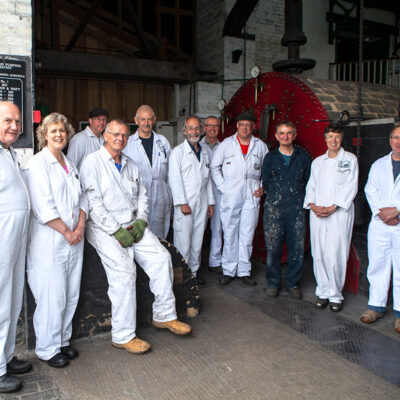Lubricators
The ornate brass objects on the cylinder covers are manually operated cylinder lubricators. They feed oil to the steam side of the piston. In their base is a valve. On the No.1 Engine, this valve is held closed by the spherical weight on the end of the arm. On the No.2 Engine, the valve is of the rotary type. The cylinders are oiled twice per day when the engines are running.

In use, approximately 250 ml (½ pint) of oil is placed in the lubricator cup. On the upstroke (when there is a vacuum on the steam side of the piston), the operator opens the valve, which sucks the oil into the cylinder. The operator then closes the valve before the upstroke is complete. Several strokes may be needed to inject all the oil.
If the operator gets the timing wrong, and has the valve open on the down stroke, then the steam pressure blows the oil out of the cup and over anything unfortunate enough to be near (i.e. at least the operator!) With ordinary lubricant, this would be, to say the least, unfortunate, but the oil used in this case is steam oil, a very viscous, sticky substance difficult to remove from skin or hair!
Honey Street Clock
The Honey Street Clock is situated on the wall of the Boiler House. It was rescued from the demolished clock tower of Honey Street Wharf, next door to the boat yard of Robbins Lane and Pinnegar, one of the principal builders of boats for the Kennet and Avon Canal. The clock tower was a wooden structure consisting of ground and first floors with the clock loft above and a large iron weather vane on top.
The clock itself was said to have come to the boat yard from a church in Bath which had burned down in about 1854. It had two faces and was notoriously difficult to maintain and keep working. This is not surprising, as many of the parts from which it was made were improvised from farm machinery. For example, some of the wheels, together with the winding mechanism, are said to have come from a disused mangle grinder. Despite this, provided that it was carefully tended by someone who understood its idiosyncrasies, it performed reasonably well. However, it did have its moments; on one Sunday morning it was said to have struck continually 50 times, much to the local residents’ exasperation!
The clock is still in operation, carefully tended by volunteers, although its timekeeping can be a little variable.

Tottenham House Pump
Wilton Water, Crofton’s principal water source, was built on land owned by the Marquis of Ailesbury. Part of the deal in obtaining this water source was that Crofton would provide Tottenham House, the Marquis’s splendid mansion, some 2 km (1¼ miles) away, with a supply of fresh water. To this end, a pump was installed on each engine. The pump on the No. 2 engine no longer exists, but the one on the No.1 engine (1812 Boulton and Watt) is still in working order, although it no longer supplies water to Tottenham House. However, the pump still serves a useful purpose in that it supplies priming water for the No.2 pump which is notoriously difficult to prime on its own. Hence the steaming day running schedule calls for an initial half hour run from No.1 before No.2 is ‘given its head’.












